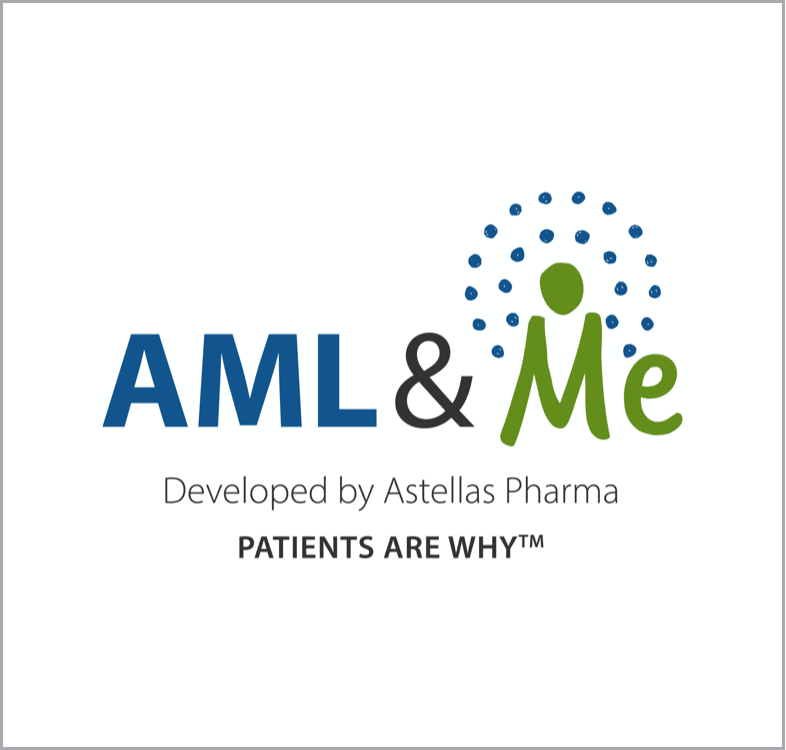Understanding bone marrow transplant
What is a bone marrow transplant?


A bone marrow transplant is one type of treatment used for Acute Myeloid Leukaemia (AML).1,2 A transplant is different from other treatments as it aims to replace abnormal cancerous white blood cells with healthy cells.
It is a longer treatment process:
1. First, the cancerous cells are destroyed using chemotherapy. Some people may also have radiotherapy at the same time.3
2. Following this, healthy cells are ‘transplanted’ into the bloodstream to replace the abnormal white cells.4 These healthy cells are donated by another person—often a family member, but sometimes someone unrelated.5,6

How are transplants given?
Stem cell or bone marrow transplants are a long and complicated process, but they can be broken down into 5 main stages:4
1. Tests - to assess your general health
2. Harvesting - getting the stem cells necessary for the transplant, either from a donor or from the person receiving the transplant
3. Conditioning - preparing the body for the transplant with high doses of chemotherapy, and potentially radiotherapy
4. Transplanting the stem cells into the body - using a central venous access (or a CVA)
5. Recovery after the transplant - it will take several days for cells to start developing, during this time, and for several weeks after, a person will stay in hospital for close monitoring to allow the medical team to monitor progress and watch for any side effects.
Unfortunately, it can take a while to recover from a transplant, and often the recovery process continues even after leaving hospital.7
Remember, if there are any words or terms you don’t understand, the Terminology Explained document can help guide you.
Who is offered a transplant?
Everyone’s AML is different, and treatment with a transplant is not suitable or possible for everyone. Doctors will carefully consider many factors when deciding if a transplant will be beneficial. Having a transplant is a long and often arduous process and doctors will make assessments on an individual basis, based on several important factors:
1. AGE
Age will be considered when offering transplants as the procedure tends to be more successful in people who are in good general health.4
2. RISK OF AML RELAPSE
Doctors will consider how likely an AML relapse is, as the aim of the transplant is to prevent future relapses.1
3. GENERAL HEALTH
Typically, people need to have a good overall level of health for the transplant to be successful.4 During the process, a person will be ‘immunocompromised’ which means that they aren’t able to fight off infection or disease alone.8 It’s therefore very important to ensure that they are healthy enough for the procedure to be carried out.4
4. RESPONSE TO PREVIOUS TREATMENTS
Doctors will review a person’s earlier response to treatment and its impact on their body.
5. SUPPORT SYSTEM
Conditioning treatment (high doses of chemotherapy and sometimes radiotherapy) will be given before a transplant,4 and so there will be a level of after-transplant care that will need to be considered. This may mean that a person will be in hospital for a longer period of time than a typical chemotherapy cycle. Doctors will need to be assured that a strong and secure support system is in place to support them both pre- and post-transplant.
Speak with your doctors or nurses if you want to learn more or have any concerns.
When are transplants offered?
Transplants can be offered at various stages of treatment. Most commonly, they are recommended after the first round of treatment with chemotherapy. Typically, patients will have four cycles of treatment, where a 'round' of chemotherapy is given over a few days, followed by several weeks of recovery, until the next cycle begins.9 Although, doctors will sometimes offer transplants to people in later stages of treatment.5,6
Mairead, an AML nurse, shares her personal and professional insights on transplants as a treatment for AML.
After a transplant
Following the procedure, most people can expect a 6-12 month recovery before feeling fit and well again.
As with all treatments, transplants have possible side effects.6 Remaining in hospital following a transplant means that any potential side effects can be monitored and treated by doctors.
Once you've left hospital, the haematology team will schedule regular follow ups to monitor your recovery. They will be able to advise what to expect and what potential longterm side effects to watch out for.
Many hospitals have a 24 hour hotline - remember to use it. If you have any symptoms that concern you, do not wait for your next appointment, contact your hospital immediately.
Support material

AML & Me Podcast
Zack Pemberton-Whiteley from Leukaemia Care talks to Ghyl, who was diagnosed with AML in 2017, her husband Tom and their haematologist Professor Marc Mansour about life before and after AML, the bone marrow transplant process and the things that helped them cope during that time.
Find out more about
Managing AML - overview
What is the aim of the treatment? Is it the same for everyone? Find the answers to these questions and more
In-hospital treatment
What happens when you have treatment in hospital? what is a clinical trial? Find the answers to these questions and more.
Treatment at home
How is treatment given? What is a 'day-ward'? Find the answers to these questions and more
References
1. Saultz JN and Garzon R. Acute Myeloid Leukemia: A Concise Review. J Clin Med 2016; 5 20160305.
2. Gregory TK, Wald D, Chen Y, et al. Molecular prognostic markers for adult acute myeloid leukemia with normal cytogenetics. J Hematol Oncol 2009; 2: 23. 20090602.
3. NHS. Acute Myelod Leukemia Treatment. https://www.nhs.uk/conditions/acute-myeloid-leukaemia/treatment/ [Last accessed April 2022].
4. NHS. Stem cell and bone marrow transplants. https://www.nhs.uk/conditions/stem-cell-transplant/what-happens/ [Last accessed April 2022].
5. Song K and Lipton J. Is it appropriate to offer allogenic hematopoietic stem cell tranplantation to patients with primar refractory acute myeloid leukaemia? Bone Marrow Transplant 2005; 36: 183-191.
6. Patriarca F, Sperotto A, Lorentino F, et al. Donor Lymphocyte Infusions After Allogeneic Stem Cell Transplantation in Acute Leukemia: A Survey From the Gruppo Italiano Trapianto Midollo Osseo (GITMO). Front Oncol 2020; 10: 572918. 20201015.
7. Cancer Research UK. Life after transplant for acute myeloid leukaemia (AML). https://www.cancerresearchuk.org/about-cancer/acute-myeloid-leukaemia-aml/living-with/life-after-transplant-for-acute-myeloid-leukaemia [Last accessed April 2022].
8. NHS. Acute Myeloid Leukaemia Complications. https://www.nhs.uk/conditions/acute-myeloid-leukaemia/complications/[Last accessed April 2022].
9. Blood Cancer UK. Acute Myeloid Leukemia Treatment phases. https://bloodcancer.org.uk/understanding-blood-cancer/leukaemia/acute-myeloid-leukaemia/aml-treatment-side-effects/aml-treatment-types-phases/ [Last accessed April 2022].
HAE_2022_0016_IE | April 2022

